As mentioned at the 2015 AGM, Blackcurrant Gall Mite has been found on the allotments this year. They are a serious problem which can stunt the growth of the plants and can reduce fruit production.
Lifecycle of Blackcurrant Gall Mite
The mites are microscopic in size, about 0.25mm in length. They live inside the dormant buds and suck sap from the embryonic leaves. An infested bud may contain hundreds of mites. They breed within the buds from January to April and breed again from June to September.
In May the mites emerge from the buds and produce silk threads to climb along to spread to other healthy buds and plants. This process will continue throughout the summer and the mites will eventually overwinter in the buds.
The mites can be carried by the wind and also on the bodies of aphids so the risk of spread is quite considerable.
How to recognise it
 The first symptom is a round swollen bud; healthy buds are pointed in appearance. The buds may then fail to open or will produce distorted leaves if they do open. The problem is most obvious in winter and early spring.
The first symptom is a round swollen bud; healthy buds are pointed in appearance. The buds may then fail to open or will produce distorted leaves if they do open. The problem is most obvious in winter and early spring.
Why it is a problem
Infected buds often fail to open or will produce distorted leaves, stunted foliage and few or no flowers. The mites carry the virus responsible for blackcurrant reversion disease which stunts the plant and substantially reduces fruit production.
Where you are likely to find it
Primarily in blackcurrant plants but it can also affect other Ribes species; redcurrants, whitecurrants, gooseberries and many ornamental plants. The Jostaberry is a gooseberry/blackcurrant hybrid.
How to get rid of it
As soon as it is noticed prune out any stems where big bud mites are present and destroy them, burning is the best option, do not put them on your compost heap. If plants are badly infested they should be dug up and destroyed. This is best done in the winter when the mites are inactive to limit the spread of the infestation. In cases of light infestation the big buds should be picked off and disposed of as above.
Spraying with a sulphur formulation in May and June (when the mites emerge from the buds and migrate) can be effective. There are no chemical means of attacking the mite while it is in the bud.
Encourage natural predators like lacewings by providing food sources such as poached-egg plants (Limnanthes Douglasii).
If the plant is infected by blackcurrant reversion as a result of the big bud mite infestation then it cannot be cured and perhaps consider planting cultivars with resistance to the disease; such as Ribes Nigra ‘Ben Hope’ and ‘Ben Gairn’
